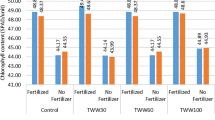Summary
When plant storage tissue is cut into thin disks it rapidly develops a high capacity to absorb phosphate from dilute solutions. The recent trend has been to attribute the development of this ability to the increased metabolic activity of bacteria known to be containing the tissue. Data presented in this paper shows that bacterial contamination of the tissue does contribute to the apparent uptake of phosphate by the disks. However, during the ageing process the number of bacteria decrease and therefore contribute less to the total uptake in the aged tissue. If the tissue is prepared and maintained in a sterile condition it is still able to develop a high capacity for phosphate absorption during ageing.
Similar content being viewed by others
References
Bacon, J. S. D., MacDonald, I. R., Knight, A. H.: The development of invertase activity in slices of the root of Beta vulgaris washed under aseptic conditions. Biochem. J. 94, 175–182 (1965).
Barber, D. A.: Microorganisms and the inorganic nutrition of higher plants. Ann. Rev. Plant Physiol. 19, 71–88 (1968).
Click, R. E., Hackett, D. P.: The role of protein synthesis in the development of respiration in potato tuber slices. Proc. nat. Acad. Sci. (Wash.) 50, 243–250 (1963).
Edelman, J., Hall, M. A.: Development of invertase and ascorbate oxidase activities in mature storage tissue of Helianthus tuberosus. Biochem. J. 95, 403–410 (1965).
Ellis, R. J.: Activation of protein synthesis by microscomes from ageing beet disks. Plant Physiol. 42, 1297–1299 (1967).
Hopkins, E. F.: Variation in sugar content of potato tubers caused by wounding and its possible relation to respiration. Bot. Gaz. 84, 75–88 (1927).
Laties, G. G.: Respiration and cellular work and the regulation of respiration rates in plants. Survey biol. Progr. 3, 215–299 (1957).
Leaver, C. J., Edelman, J.: Nucleic acid synthesis in carrot tissue slices. Biochem. J. 97, 27p (1965).
Loughman, B. C.: Uptake and utilization of phosphate associated with respiratory changes in potato tuber slices. Plant Physiol. 35, 418–423 (1960).
MacDonald, I. R.: Bacterial infection and ion absorption capacity in beet disks. Ann. Bot. 31, 163–172 (1967).
Palmer, J. M.: The influence of growth regulating substances on the development of enhanced metabolic rates in thin slices of beetroot storage tissue. Plant Physiol. 41, 1173–1178 (1966).
Reed, D. J., Kolattukudy, P. E.: Metabolism of red beet slices. I. Effect of washing. Plant Physiol. 41, 653–660 (1966).
Vaughan, D., MacDonald, I. R.: Development of soluble and insoluble invertase activity in washed storage tissue slices. Plant Physiol. 42, 456–457 (1967).
Author information
Authors and Affiliations
Rights and permissions
About this article
Cite this article
Palmer, J.M. The influence of microbial contamination of fresh and washed beetroot disks on their capacity to absorb phosphate. Planta 93, 48–52 (1970). https://doi.org/10.1007/BF00387651
Received:
Issue Date:
DOI: https://doi.org/10.1007/BF00387651




